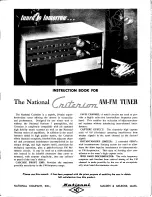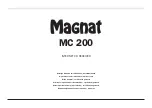
EB200 Manual
Remote control
4052.2000.02 4.3
E-7
4.4 Structure and syntax of the device messages
4.4.1 SCPI introduction
SCPI (Standard Commands for Programmable Devices) describes a standard command set for
programming devices, irrespective of the type of device or manufacturer. The goal of the SCPI
consortium is to standardize the device-specific commands to a large extent. For this purpose, a model
was developed which defines the same functions inside a device or for different devices. Command
systems were generated which are assigned to these functions. Thus it is possible to address the same
functions with identical commands. The command systems are of a hierarchical structure. Fig. 4-1
illustrates this tree structure using a section of command system SENSe which operates the sensor
functions of the devices. The other examples regarding syntax and structure of the commands are
derived from this command system.
SCPI is based on standard IEEE 488.2, ie it uses the same syntactic basic elements as well as the
common commands defined in this standard. Part of the syntax of the device responses is defined with
greater restrictions than in standard IEEE 488.2 (see "Responses to queries" on page 8).
4.4.2 Structure of a command
The commands consist of a so-called header and, in most cases, one or more parameters. Header and
parameter are separated by a "white space" (ASCII code 0 to 9, 11 to 32 decimal, eg blank). The
headers may consist of several keywords. Queries are formed by directly appending a question mark to
the header.
Note:
The commands used in the following examples are not in every case implemented in the device.
Common commands
Common commands consist of a header preceded by an asterisk "
*
"
and one or several parameters, if any.
Examples:
*RST
RESET, resets the device
*ESE 253
EVENT STATUS ENABLE, sets the bits of
the event status enable register
*ESR?
EVENT STATUS QUERY, queries the
contents of the event status register.
















































